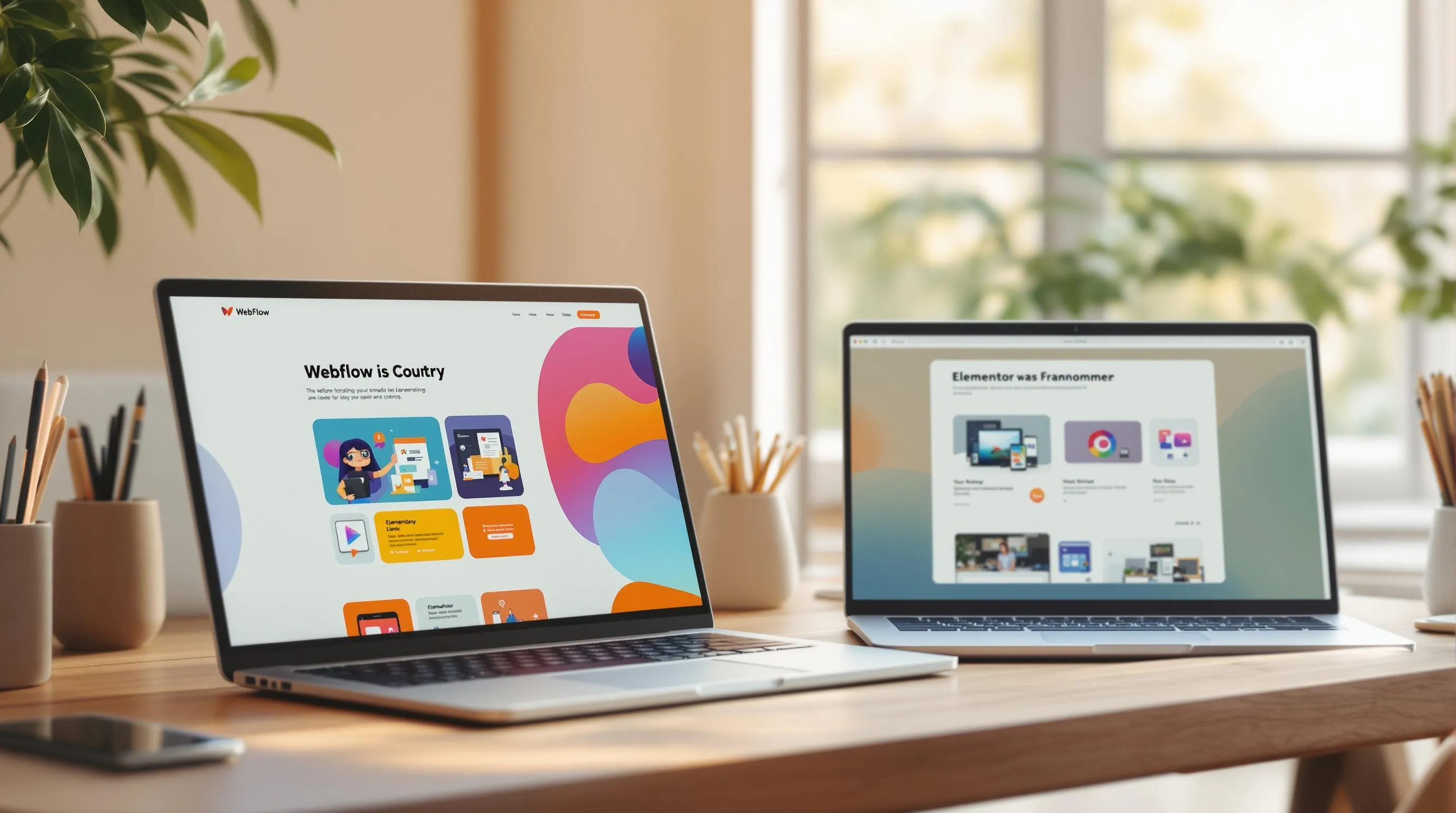Webflow vs Bubble: Which Website Builder is Right for You
If you're deciding between Webflow and Bubble for your next project, here's what you need to know upfront:
- Webflow is best for design-focused websites like marketing sites, portfolios, and e-commerce. It offers pixel-perfect design tools and a strong CMS for content management.
- Bubble excels in building complex web applications like marketplaces, SaaS products, and internal tools. It provides full-stack development capabilities with built-in databases and workflow automation.
Quick Comparison
| Feature | Webflow | Bubble |
|---|---|---|
| Focus | Website design | Full-stack app development |
| Best For | Static websites, e-commerce | Interactive apps, SaaS products |
| Design Approach | Advanced CSS, visual customization | Functional layout, quick prototyping |
| Backend Features | Limited, CMS-focused | Robust, includes database & workflows |
| Learning Curve | Easier for designers | Steeper for complex apps |
| Starting Price | $14/month | $29/month |
Choose Webflow if you need visually stunning websites with a focus on design and content. Opt for Bubble if your project requires backend logic, user interactivity, and scalability.
Core Features: Webflow vs Bubble

Design Tools Comparison
Webflow and Bubble take different approaches when it comes to visual design. Webflow focuses on precise control over visual elements, offering advanced CSS tools and reusable classes to ensure consistent styling across projects.
"Webflow is crazy good. I feel like you guys are the first to build the right UX around styling and CSS." - Paul Irish, Chrome Dev Tools, Google
On the other hand, Bubble's interface builder is designed for quick prototyping and emphasizes arranging components for functionality rather than detailed styling.
| Feature | Webflow | Bubble |
|---|---|---|
| Design Focus | Pixel-perfect visual design | Functional layout |
| Style Control | Advanced CSS and reusable classes | Basic styling options |
| Component System | Reusable classes | Reusable elements |
| Responsive Design | Built-in responsive breakpoints | Auto-responsive elements |
| Design Flexibility | High customization | Template-based approach |
While Webflow shines in creating visually polished designs, Bubble prioritizes speed and ease of arranging functional layouts.
Backend Features
When it comes to backend capabilities, the two platforms serve different needs. Bubble functions as a full-stack solution, managing the frontend, backend, and workflow logic all within one environment. It’s equipped to handle complex data relationships and automate workflows without needing external tools.
Webflow, meanwhile, focuses its backend functionality on its Content Management System (CMS), which is ideal for organizing and managing content. For more advanced backend tasks, Webflow often requires integration with third-party services.
Learning Requirements
Both platforms provide resources to help users get started, but their learning curves differ. Webflow University offers a structured learning path with courses, guides, and hands-on materials, making it accessible for those with a background in visual design.
Bubble, due to its broader feature set, demands more time to learn. The Bubble Academy provides interactive lessons, crash courses, and coaching to help users fully grasp the platform's capabilities.
Cost Breakdown
Webflow and Bubble cater to different pricing needs. Webflow's plans are based on site performance and content management, while Bubble's pricing adjusts according to the complexity and capacity of the application. Both platforms also offer custom pricing for enterprise-level projects.
Webflow vs Bubble.io In-Depth Comparison: Choosing the Right No-Code Platform
Platform Strengths and Uses
Here’s how each platform aligns with different project needs and goals.
When to Use Webflow
Webflow is ideal for creating visually striking websites, especially for projects focused on design and content management.
Take SecondShare, a real estate firm, as an example. They used Webflow to build a custom property listing site. The platform allowed them to showcase properties through stunning visual galleries and manage their extensive portfolio with ease using Webflow’s content management system (CMS).
Another example is Unofficial Fun, which highlights Webflow's flexibility. They developed a newsletter system, an interactive schedule maker, and a sales landing page - all within Webflow.
Here’s where Webflow shines:
| Project Type | Key Benefits |
|---|---|
| Marketing Websites | Precise design control, responsive layouts |
| E-commerce Stores | Built-in CMS, efficient product management |
| Portfolio Sites | Advanced visual customization, content flexibility |
| Landing Pages | Fast deployment, A/B testing support |
| Content Platforms | Strong CMS, tools for content organization |
When to Use Bubble
Bubble excels in creating complex web apps and business tools, making it a go-to choice for data-heavy projects that require workflow automation.
For instance, Copious.Land founder Eric Quay built a marketplace for land investors in just 8 weeks using Bubble. The platform integrated features like property listing management, satellite imagery, and investor networking seamlessly.
Another great example is MaidManage, which showcases Bubble’s capability in business applications. This platform includes a custom rate calculator, Stripe Connect for payments, and a system for managing operations.
Bubble is particularly well-suited for:
| Application Type | Core Strengths |
|---|---|
| SaaS Products | Full-stack features, user management |
| Marketplaces | Database handling, payment integration |
| CRM Systems | Workflow automation, managing data relationships |
| Internal Tools | Custom logic, role-based access |
| AI Applications | API integration, managing complex workflows |
With nearly 5 million apps created and a 99.93% uptime over the past 90 days, Bubble has established itself as a reliable choice for businesses looking to scale. Powered by AWS, its cloud infrastructure ensures that applications can handle growing demands effectively.
sbb-itb-fdf3c56
Speed and Growth Limits
Page Speed Analysis
Webflow and Bubble approach page speed in distinct ways, reflecting their unique optimization strategies. Webflow leans heavily on built-in features, while Bubble relies more on manual adjustments.
Webflow includes several automatic optimizations to enhance performance:
- Lazy loading for images
- Efficient font loading with 'swap' display
- Link preloading for faster navigation
- Integration with Amazon's Cloudfront CDN and Fastly for quick content delivery
Bubble, on the other hand, uses a single-page application design. This results in longer initial load times but faster navigation once the page is loaded.
| Performance Factor | Webflow | Bubble |
|---|---|---|
| CDN Integration | Amazon Cloudfront & Fastly | Cloudflare |
| Image Optimization | Automatic lazy loading | Server-side resizing |
| Database Queries | Simple CMS queries | Database-level filtering |
| Page Structure | Multi-page | Single-page application |
These differences directly impact how each platform performs under heavy traffic.
Traffic Management
Both platforms are capable of managing high traffic, but their methods differ.
Webflow supports tens of billions of page views monthly. For Enterprise users, it offers custom hosting clusters to handle large traffic surges.
Bubble manages traffic through capacity limits, including page visits, database calls, workflows, and API calls. A standout example is the app Make Fortnite Skins. Its creator, Max, shared:
"Within 3 weeks after being introduced to Bubble, I released a fully functional version-1 of my application. Less than a day after I finished creating it there were over 150,000 visits on the page".
These strategies highlight how each platform addresses scalability and performance under pressure.
Future-Proofing Options
Looking beyond current performance, scalability is another key factor when comparing these platforms.
Webflow offers features designed for long-term growth:
- Automatic platform updates - no manual effort required
- Support for custom code integration
- Dynamic templates for scaling content
- Compatibility with external animation libraries
Bubble provides its own set of forward-thinking tools:
- Options to export data
- AI-driven frontend tools
- A commitment to open-source, ensuring its source code would be released if operations ceased
For users looking to maximize Bubble's performance, these strategies can help:
- Break complex processes into smaller tasks
- Shift heavy calculations to scheduled workflows
- Organize databases effectively to prevent inefficiencies
Decision-Making Guide
Decision Checklist
| Project Type | Best Platform | Key Considerations |
|---|---|---|
| Static Websites | Webflow | Flexible design options, SEO features |
| Landing Pages | Webflow | Fast setup, strong visual tools |
| Interactive Apps | Bubble | Handles user data, backend functionality |
| Marketplaces | Bubble | Scalable databases, user interaction tools |
| SaaS Products | Bubble | Full-stack tools, custom workflows |
| Content-heavy Sites | Webflow | CMS tools, organized content structure |
Pick the platform that matches your project’s design and backend needs. For example, Ruuster, a home-buying marketplace, uses Bubble's full-stack capabilities for features like step-by-step checklists and budget tools.
User-Specific Guidelines
When deciding, think about your experience level and project goals. Here's a quick breakdown:
Beginners
- Webflow is a great option for creating basic websites without much hassle.
- Bubble’s AI app generator can make app development easier for new users.
Intermediate Users
- Webflow’s advanced tools might need some coding knowledge.
- Bubble remains no-code but calls for strategic planning to make the most of its features.
Professional Developers
- Use Bubble for projects requiring high scalability and customization. For instance, CryptoMarketCap uses Bubble to track live data for over 18,000 cryptocurrencies.
Project-Specific Recommendations
- Webflow is ideal for projects focusing on design and static content. Its infrastructure supports high-volume content delivery across the globe.
- Bubble is perfect for building dynamic applications. For example, WorkBooking, a B2B platform for matching freelance talent, relies on Bubble’s comprehensive development tools.
Your choice should depend on your technical needs and future growth plans. Webflow shines for visually appealing static sites, while Bubble is better suited for dynamic apps with backend requirements.
Final Comparison
Here's a quick breakdown of how Webflow and Bubble stack up against each other.
Platform Differences
The two platforms cater to different needs, as shown below:
| Aspect | Webflow | Bubble |
|---|---|---|
| Primary Focus | Frontend design and development | Full-stack app development |
| Best For | Marketing websites, content platforms | Interactive apps, SaaS products |
| Design Approach | Visual interface for CSS and HTML | Component-based with built-in functionality |
| Backend Capabilities | Limited; often requires third-party tools | Includes database and workflow tools |
| Monthly Cost | Starts at $14 for basic sites | Starts at $29 for starter apps |
| Learning Curve | Easy for web designers | Beginner-friendly for non-tech users |
This table highlights the key strengths of each platform to help you decide which suits your project better.
Platform Selection Guide
Your choice depends on your project's goals. Here's a quick guide:
Choose Webflow if you need:
- Highly customized, design-driven websites
- A focus on frontend visuals and content
- Entry-level pricing starting at $14/month
Choose Bubble if you need:
- Advanced backend tools and interactive app features
- Built-in user authentication and database management
- Entry-level pricing starting at $29/month
Webflow offers dedicated hosting designed for high-traffic sites. On the other hand, Bubble's scalability hinges on how well you manage workload units as your app grows.



















































